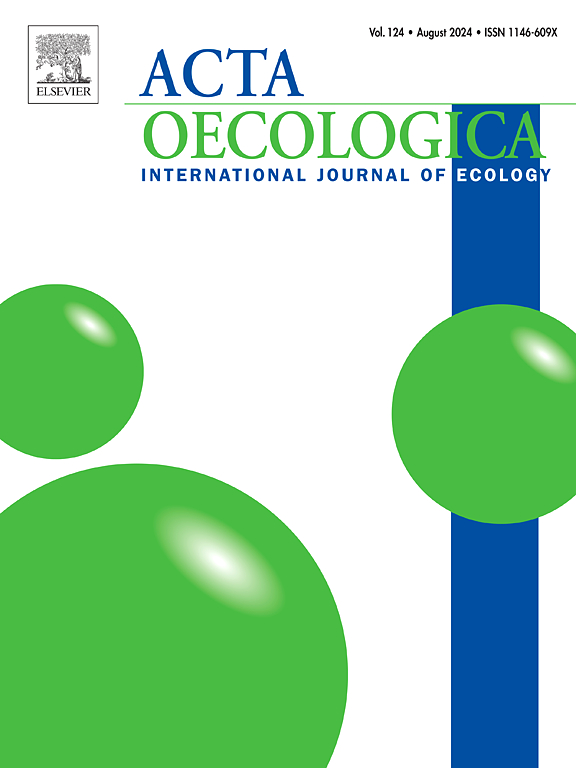Microtopography and vegetation generate uneven predation pressure on forest insects
IF 1.3
4区 环境科学与生态学
Q3 ECOLOGY
Acta Oecologica-International Journal of Ecology
Pub Date : 2024-09-27
DOI:10.1016/j.actao.2024.104031
引用次数: 0
Abstract
Predation plays an important role in the coexistence of multiple species within forest ecosystems. It is spatially heterogeneous and influenced by the surrounding environment at different spatial scales. Studies focusing on multiple environmental factors in systems with high spatial complexity are lacking, but elucidating the effects of local environmental factors within a forest could assist in understanding the effects of local differences in predation pressures on multispecies coexistence. Here, we examined the effects of microtopography and vegetation on predation pressure using the model caterpillar method. We hypothesized that differences in microtopography and vegetation types would result in different predation pressures on invertebrates within a forest. Insect attacks were dominant throughout the study period. The attack rates on the model caterpillars were also lower on hill tops and evergreen deciduous trees. Predation pressure within the forest was heterogeneous and independently influenced by topography and vegetation type. Our results suggest that environmental heterogeneity within forests may lead to highly variable predation pressures and affect multispecies coexistence. This study suggests that microtopography and vegetation types within forests should be considered for biological control.
微地形和植被对森林昆虫造成不均衡的捕食压力
捕食在森林生态系统中多物种共存的过程中扮演着重要角色。捕食在空间上是异质的,在不同的空间尺度上受到周围环境的影响。目前还缺乏对具有高度空间复杂性的系统中多种环境因素的研究,但阐明森林中局部环境因素的影响有助于理解捕食压力的局部差异对多物种共存的影响。在这里,我们利用毛虫模型法研究了微地形和植被对捕食压力的影响。我们假设,微地形和植被类型的差异会导致森林内无脊椎动物捕食压力的不同。在整个研究期间,昆虫的攻击占主导地位。在山顶和常绿落叶树上,模型毛虫的攻击率也较低。森林中的捕食压力是不均匀的,并受地形和植被类型的独立影响。我们的研究结果表明,森林内环境的异质性可能会导致捕食压力的高度变化,并影响多物种的共存。这项研究表明,生物防治应考虑森林内的微地形和植被类型。
本文章由计算机程序翻译,如有差异,请以英文原文为准。
求助全文
约1分钟内获得全文
求助全文
来源期刊
CiteScore
3.60
自引率
0.00%
发文量
57
审稿时长
>0 weeks
期刊介绍:
Acta Oecologica is venue for the publication of original research articles in ecology. We encourage studies in all areas of ecology, including ecosystem ecology, community ecology, population ecology, conservation ecology and evolutionary ecology. There is no bias with respect to taxon, biome or geographic area. Both theoretical and empirical papers are welcome, but combinations are particularly sought. Priority is given to papers based on explicitly stated hypotheses. Acta Oecologica also accepts review papers.

 求助内容:
求助内容: 应助结果提醒方式:
应助结果提醒方式:


